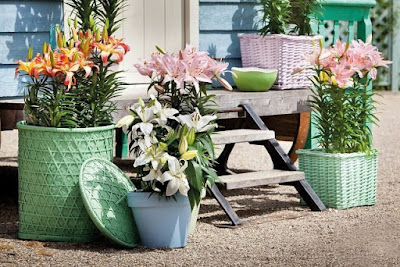 |
| How to plant Lily bulbs - http://www.gardeningknowhow.com/ |
The genus Lilium is well known for providing gardeners with a wide range of highly ornamental, tall, flowering perennials. Furthermore, many of the species, as well as a huge number of selected cultivars, are suitable for growing in temperate and subtropical regions. Despite being found across much of the new and old world, lilies are specialist plants, and across the genus can be found growing in wide range of conditions. Unfortunately when buying lily bulbs there is often little, if any, cultural information available. That being said the majority of species and cultivars require fundamentally similar growing conditions which are covered below.
 |
| Lily bulbs |
2. Given favourable conditions, almost all lily bulbs can be planted in the garden, or in deep, suitably sized pots and containers. When planting in pots use a 50:50 mix of ericaceous compost and John Innes 'No 3', but provide a 5cm (2in) basal layer of drainage material, such as crocks top by small stones or grit. Some lily species such as L. auratum and L. speciosum are known to be lime-haters. These will be best planted into ericaceous compost only. If available choose a soil-based blend such as John Innes 'Ericaceous Compost'.
 |
| Pot grown lilies - https://www.gardenia.net/ |
4. Lilies tend to perform best when planted in a south-facing position (northern hemisphere), with a slightly sloping aspect, in sun or part shade. Plant the bulbs a minimum of 4 inches deep to help provide basal support, and larger bulbs at a depth of approximately 2½-3 times the height of the bulb, except for Lilium candidum which should be planted at the surface. All lily bulbs should be planted with their basal plate facing downwards, and the pointed tip of the bulb scales pointing upwards.
 |
| Lilium illustration |
6. When planting in the garden, create groups of three to five using roughly the same sized bulbs. Space these groups 8-10 inches apart in mass plantings. In containers, plant the bulbs near the edge for additional support at a rate of approximately 3 bulbs to a 10 inch pot. Specimens with heavy flower heads are likely to need staking.
7. For pot grown specimens, ensure the compost is moist at all times, but not waterlogged. Feed with a high potassium liquid fertiliser every couple of weeks during the growing season.
8. Take care when watering to avoid getting the blooms wet. If lily flowers become too wet and do not dry out before the cooler temperatures of nightfall set in, fungal infections may have an opportunity to take hold.
For related articles click onto the following links:
HOW TO GROW GLADIOLI
HOW TO GROW GLADIOLI FROM SEED







No comments:
Post a Comment